Within the domain of professional audio equipment, the craftsmanship and sonic performance of condenser microphones remain paramount considerations. Positioned in the thousand-yuan bracket, Alctron’s X50B MKII—a transistor-equipped condenser mic—boasts standout features including a 34mm gold-plated large-diaphragm capsule, handcrafted cardioid polar pattern element, FET (Field-Effect Transistor) technology, and an all-aluminum chassis. This review evaluates its balance between cost-effectiveness and professional capability across four key dimensions: industrial design, pickup performance, noise suppression, and application versatility. Through hands-on testing and subjective listening assessments, we delve into its actual performance characteristics.
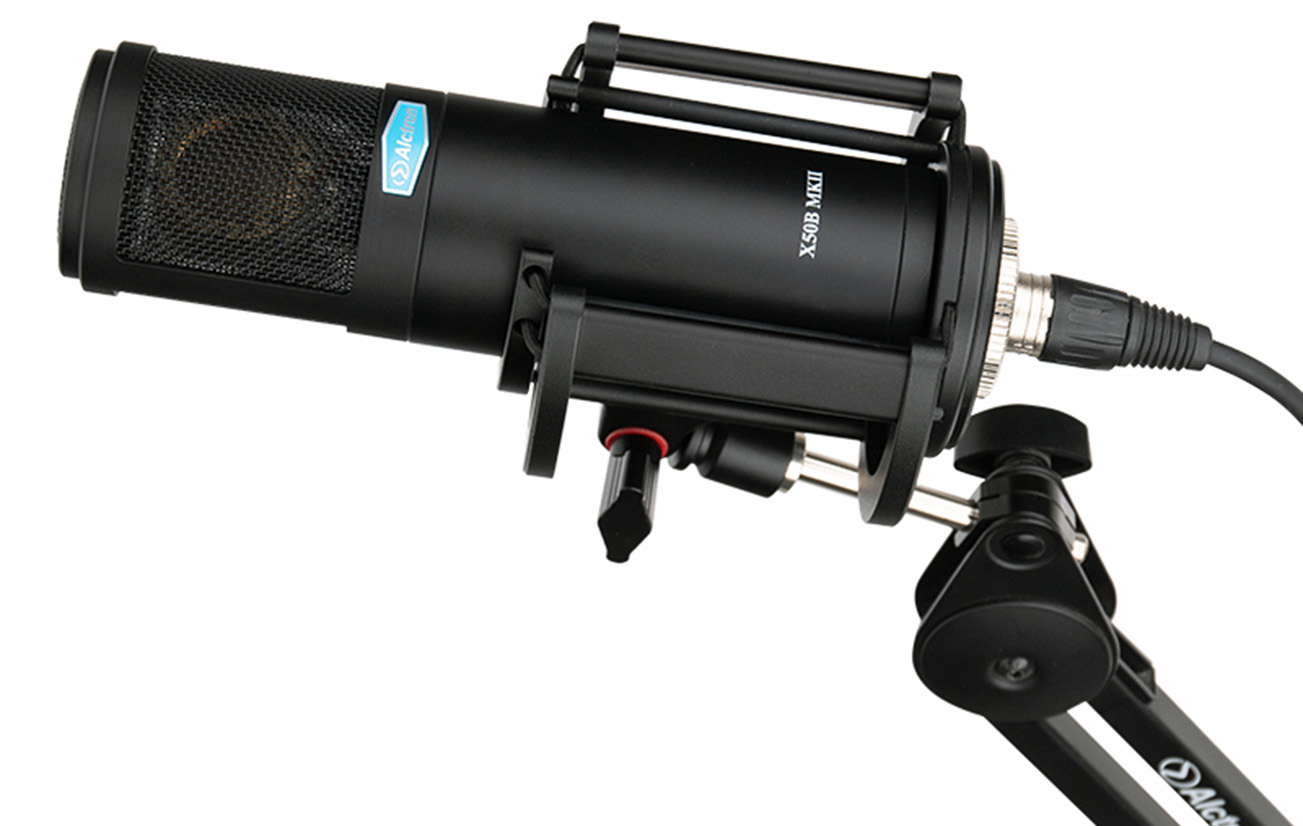
Appearance, Construction Quality & Accessories
Featuring an all-aluminum metal chassis, the X50B MKII embodies a harmonious blend of robustness and precision. Its housing is formed through integrated aluminum extrusion, finished with a matte anodized surface treatment—striking an optimal balance between lightweight design (net weight ~560g) and interference resistance. Enhanced electromagnetic shielding capabilities effectively minimize radio frequency interference (RFI).
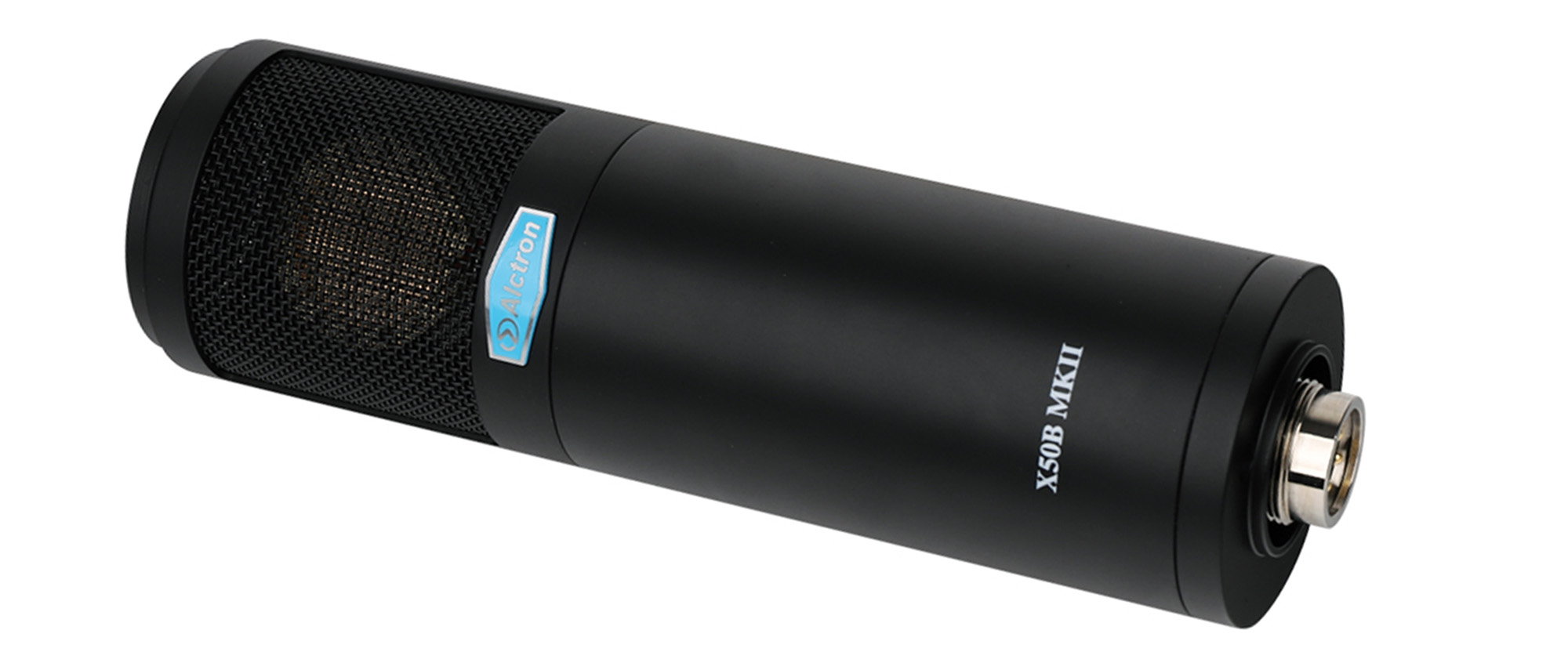
The shell craftsmanship is commendable, with details well-handled.
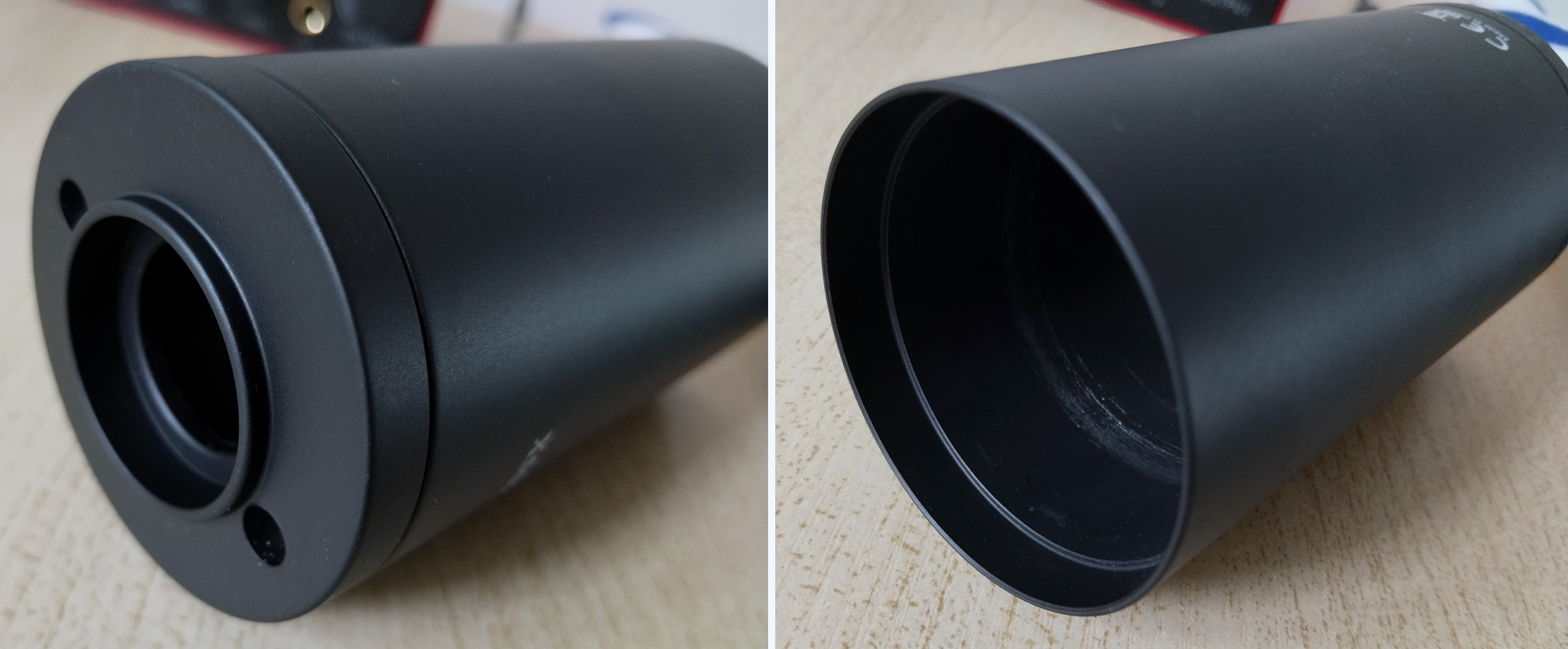
The capsule assembly incorporates a traditional aluminum grille frame, which boosts mechanical durability while safeguarding the capsule and maintaining a stable operational environment.
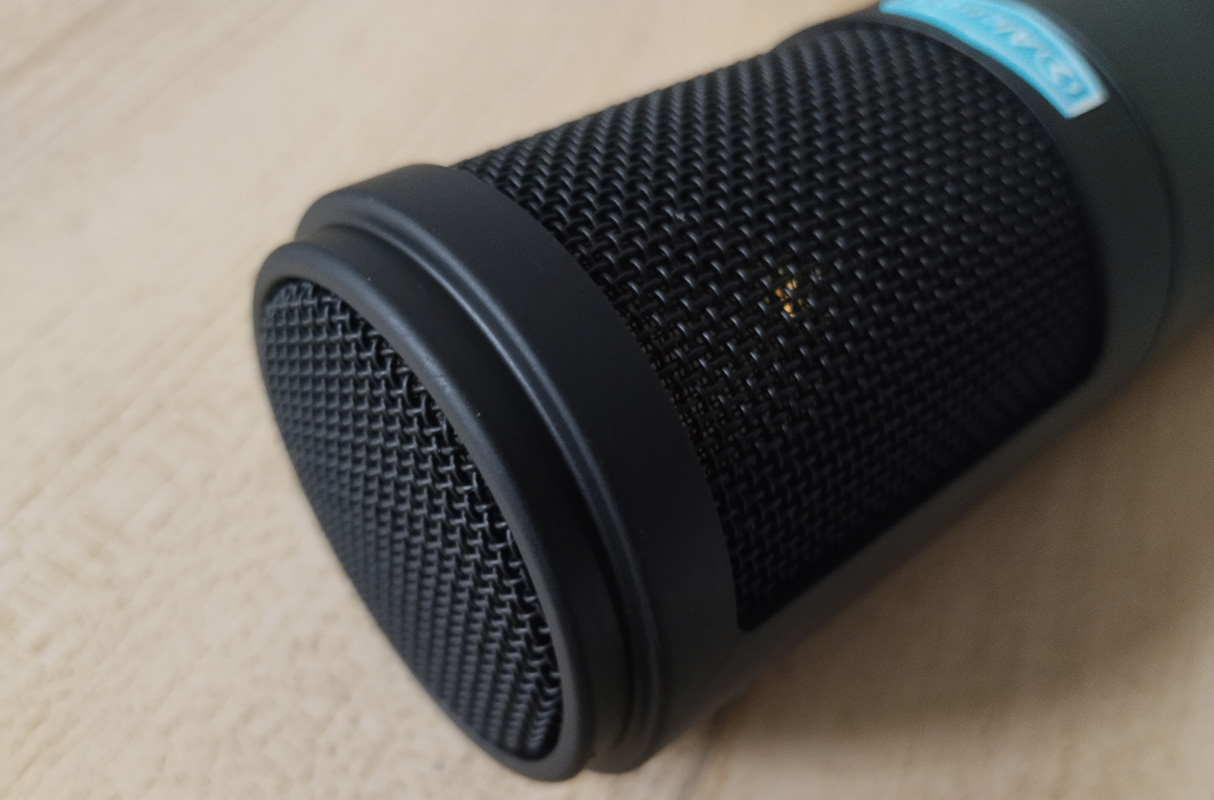
The grille frame is covered by a dual-layer mesh, delivering physical protection while simultaneously enabling acoustic optimization and wind noise reduction. Such a design is commonly found in mid-to-high-end condenser microphones.
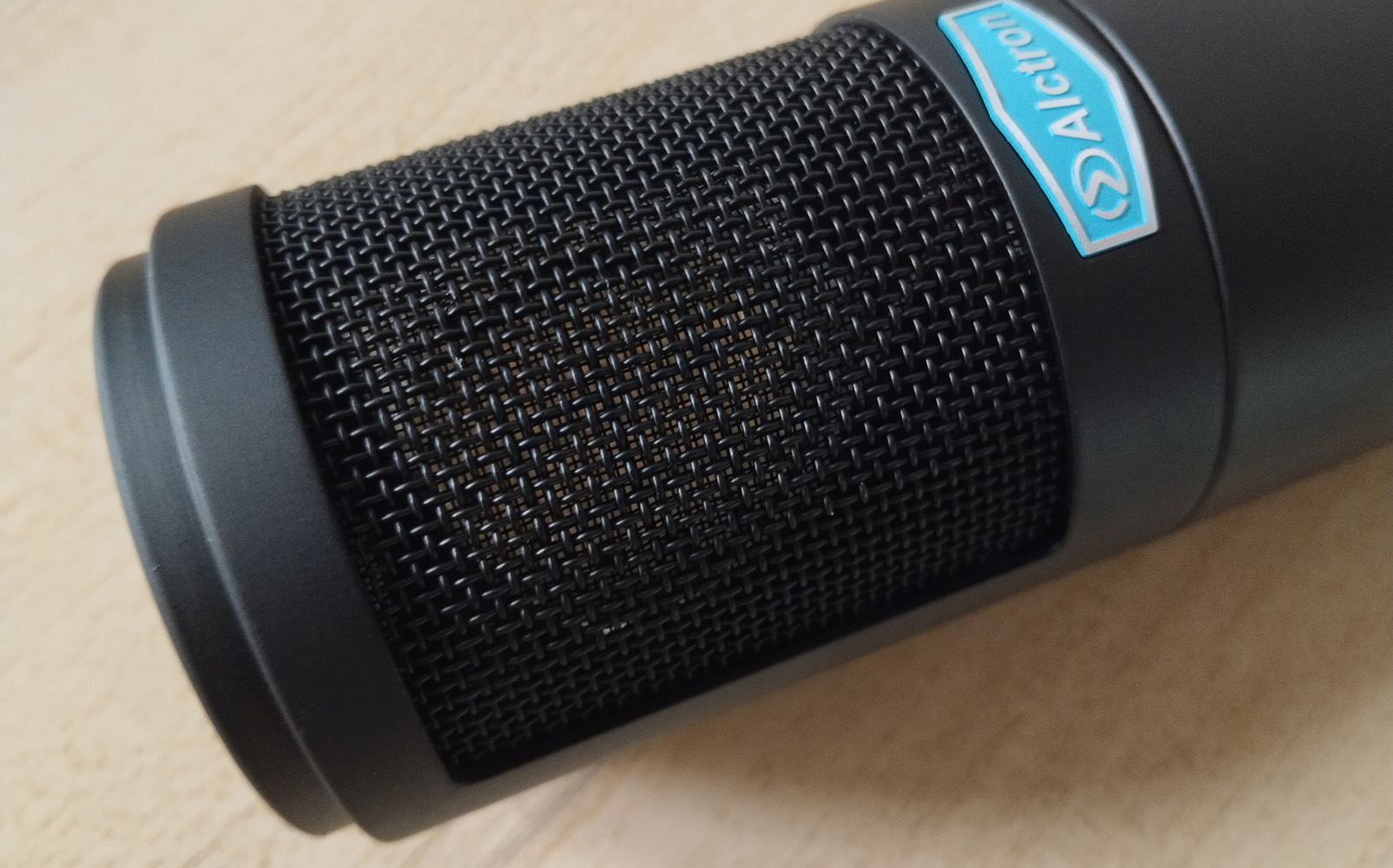
The microphone features a 3-pin XLR (Canon) connector at its output, serving as a standard balanced output interface that ensures reliable connectivity for balanced signal transmission.
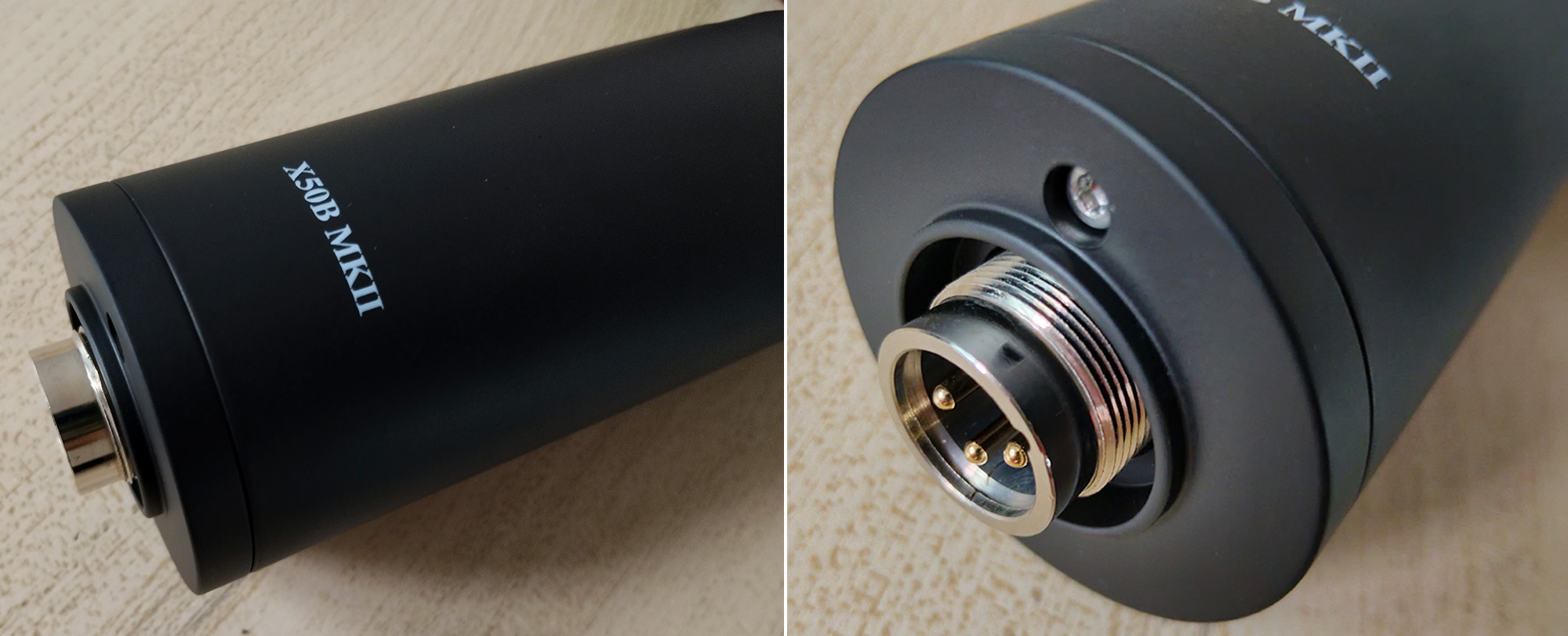
The XLR connector integrates a threaded screw mount for attaching the shock mount. As part of the standard package, the microphone comes with a matching all-metal shock mount and pop filter, bundled together with the X50B MKII inside a flight case (see image below). This configuration aligns with the typical accessory standards found in mid-to-high-end microphone setups.
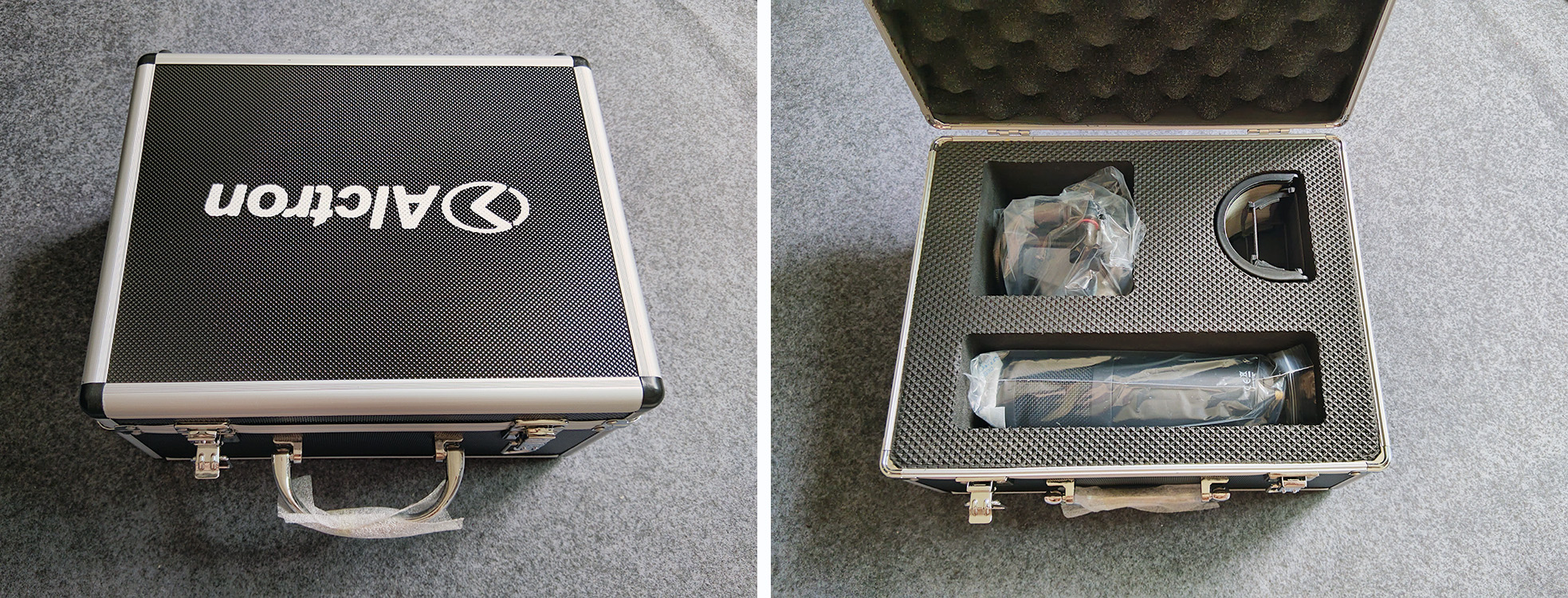
Standard configuration: X50B MKII Microphone + All-Metal Shock Mount + Pop Filter + Leather Pouch + User Manual. Visual reference available below.

Although classified as auxiliary accessories, the shock mount and pop filter remain integral components of the product. Their craftsmanship, material quality, and overall build standards match those of the X50B MKII microphone itself. The images below showcase detailed views of the all-metal shock mount and pop filter from multiple angles.
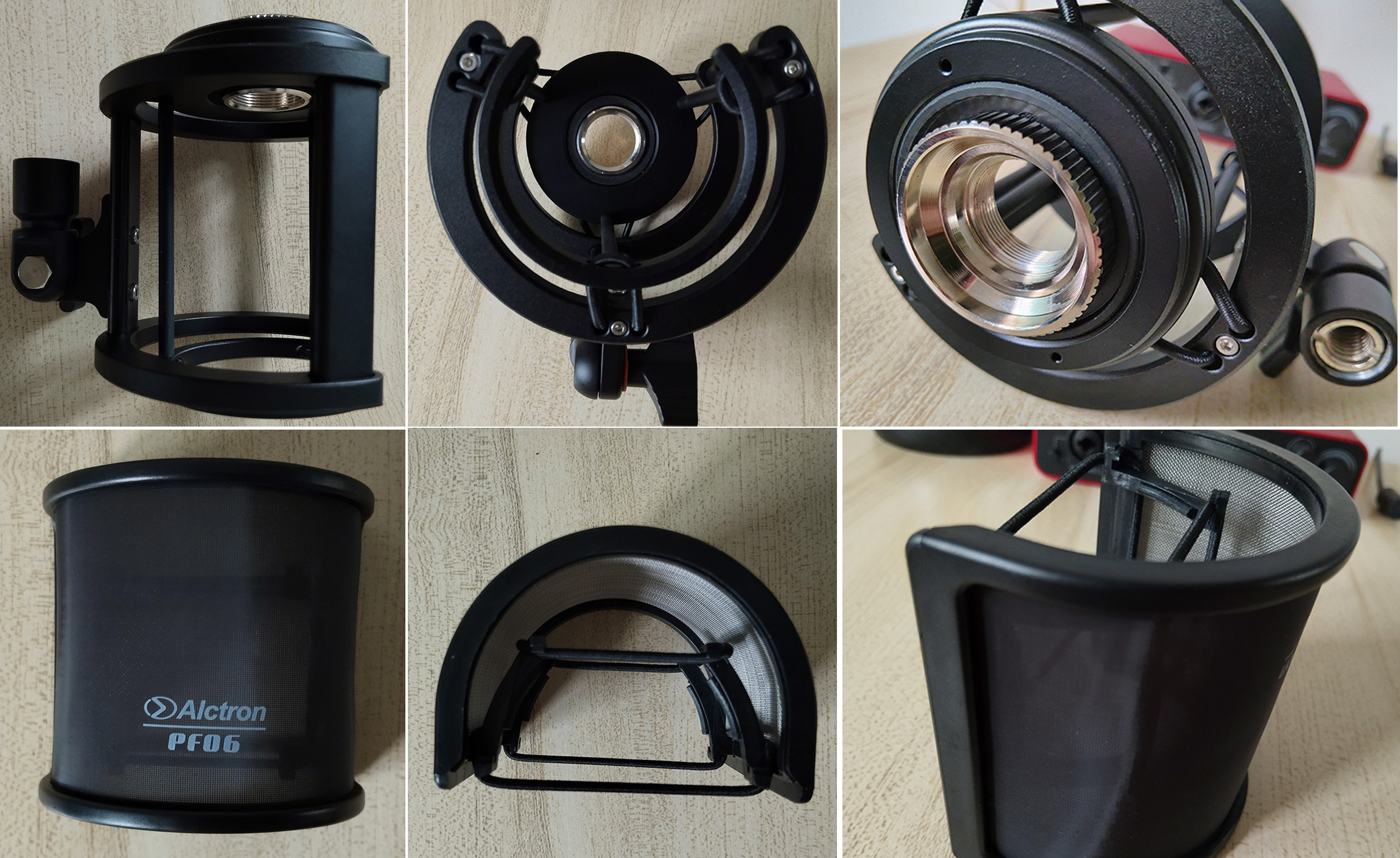
Technical Parameters and Audio Features
Type | FET condenser mic |
Polar pattern | Cardioid |
Cpasule | 34mm |
Frequency response | 20Hz-20kHz |
Sensitivity | -37dB±2dB |
Impedance | ≤200Ω |
Equivalent noise level | 17dB |
Max SPL | 125dB |
S/N ratio | 75dB |
Dynamic range | 101dB |
Self noise | 111dB |
Power supply | 48V phantom power |
Output connector | 3-pin XLR |
The standout feature of the X50B MKII microphone is its hand-assembled cardioid polar pattern capsule, featuring evenly tensioned diaphragms that ensure consistent frequency response. Alctron states that each pickup head undergoes human ear-based frequency response calibration, with less than a 0.3 dB variation in the 1 kHz frequency point among every three microphones within the same batch—outperforming comparable mass-produced models. Its exceptional performance is further evidenced by its technical specifications.
Utilizing a transistor-powered condenser design, it offers faster transient response and lower power consumption compared to vacuum tube microphones, making it ideal for live performances or portable recording setups. The 34 mm large-diaphragm capsule excels at capturing low-frequency details, delivering rich sonic character perfect for vocals, instruments, and applications demanding full-bodied tone. However, its larger physical size necessitates robust shock mounting solutions. To address this, the microphone comes equipped with a dedicated shock mount and pop filter, optimizing operational stability and acoustic performance.
It exhibits a classic cardioid polar pattern (depicted right). Sensitivity peaks at 0° on-axis (reference 0 dB), with rear rejection reaching approximately -20 dB at 180° off-axis, and side rejection averaging -6 dB at 90°/270°. This effectively isolates the primary sound source while rejecting ambient noise from the sides and rear—making it well-suited for solo sources like broadcasters or lead vocalists. Note that in untreated indoor spaces, reflections may introduce unevenness in the frequency response, and multi-angle placement will require careful positioning adjustments.

Frequency Response (see left graph above): Covering the full audible spectrum (20Hz–20kHz), its gradual natural roll-off below 30Hz effectively suppresses ambient low-frequency rumble. Around 2kHz, there’s approximately 4 dB of boost to enhance vocal/instrument presence and clarity. The high-frequency range (5kHz–16kHz) features progressive elevation, brightening timbre with enhanced definition and airiness—though caution is advised in the sibilance-prone zone (5kHz–8kHz). Peak gain near 10kHz delivers abundant "air" for spatial openness. Overall, the flat frequency curve ensures faithful reproduction of source material.
Sensitivity & Gain Requirements: With a moderate sensitivity rating of -37dB ±2dB (per IEC 60268-4 standards), it requires medium-to-high gain preamplification. Optimal for close-to-midfield recording (20–50cm); distant placement risks weakened signal strength and elevated noise floor.
Impedance & Signal Integrity: Impedance ≤200Ω ensures seamless compatibility with professional audio interfaces/preamps, minimizing signal loss over long cable runs. Equivalent noise level of 17dB(A) and self-noise of 111dB outperform most entry-level microphones, excelling in quiet environments—though post-processing may be needed for ultra-low signals (e.g., ASMR).
Dynamic Range & SPL Handling: A generous 101dB dynamic range captures nuanced details and transient peaks (e.g., drum hits, operatic vocals), surpassing typical dynamic microphones (~80dB). Max sound pressure level (SPL) of 125dB accommodates loud sources (electric guitar cabs, percussion), though approaching this ceiling increases distortion risk—using a dedicated attenuator pad (e.g., -10dB) is recommended for safety. Notably, the microphone lacks an integrated PAD function, representing a potential future upgrade.
Signal-to-Noise Ratio (SNR): At 75dB (above-average), its limited headroom for post-recording noise reduction underscores the importance of controlling ambient noise during recording sessions.
Internal Design: Featuring a JFET (Junction Field-Effect Transistor) for impedance conversion and signal amplification, this critical component directly shapes the microphone’s noise performance, dynamic range, and tonal character. The accompanying diagram illustrates the X50B MKII’s internal architecture.
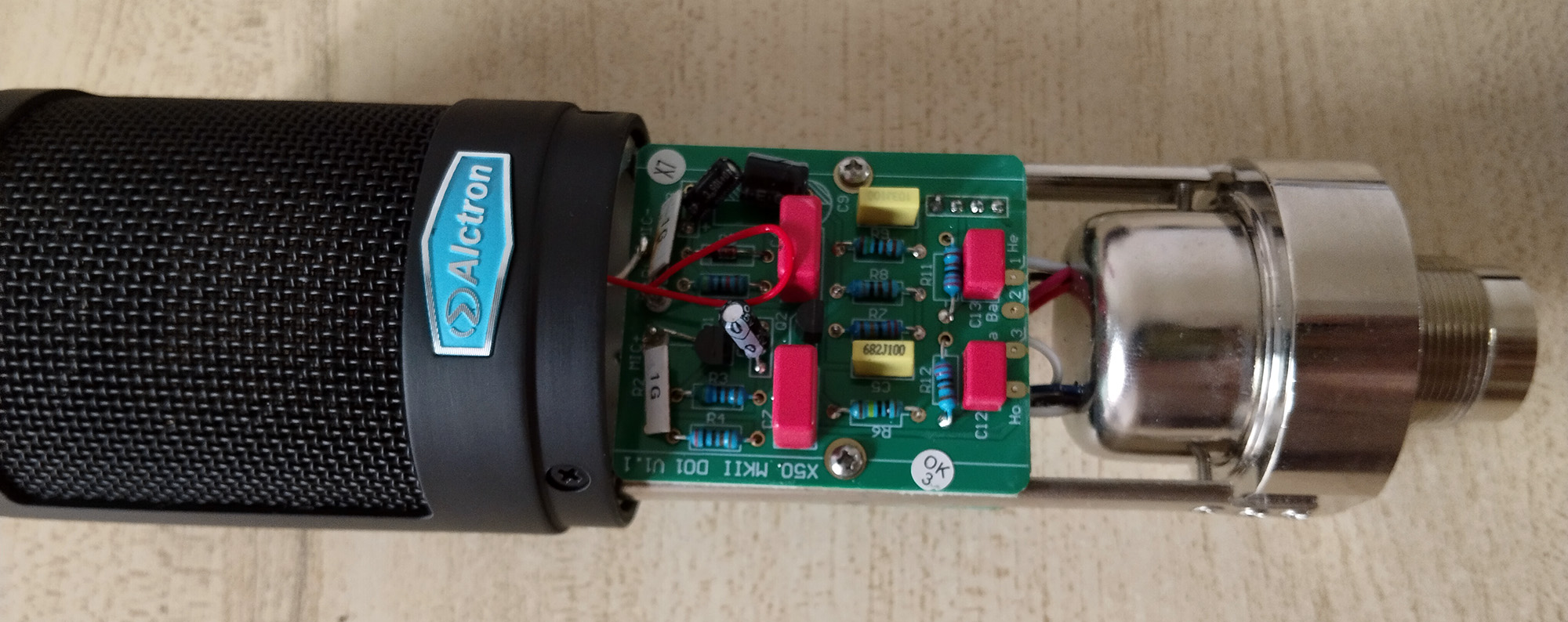
As illustrated, the microphone employs a classic JFET + transformer-coupled architecture. This design strikes a balance between the low cost of electret microphones and the noise suppression demands of professional audio systems, aligning with the circuit design principles of renowned models like the Neumann U87 and AKG C414. The output coupling capacitor is omitted from the circuit, relying instead on the transformer for DC isolation. Positioned within a metal enclosure at the rear of the circuit (see red circle in the image below), the transformer features a standard "audio transformer" package, with its metal housing effectively suppressing electromagnetic interference. Crucially, this transformer delivers true balanced signals, offering superior performance over the pseudo-balanced outputs characteristic of transformerless designs.
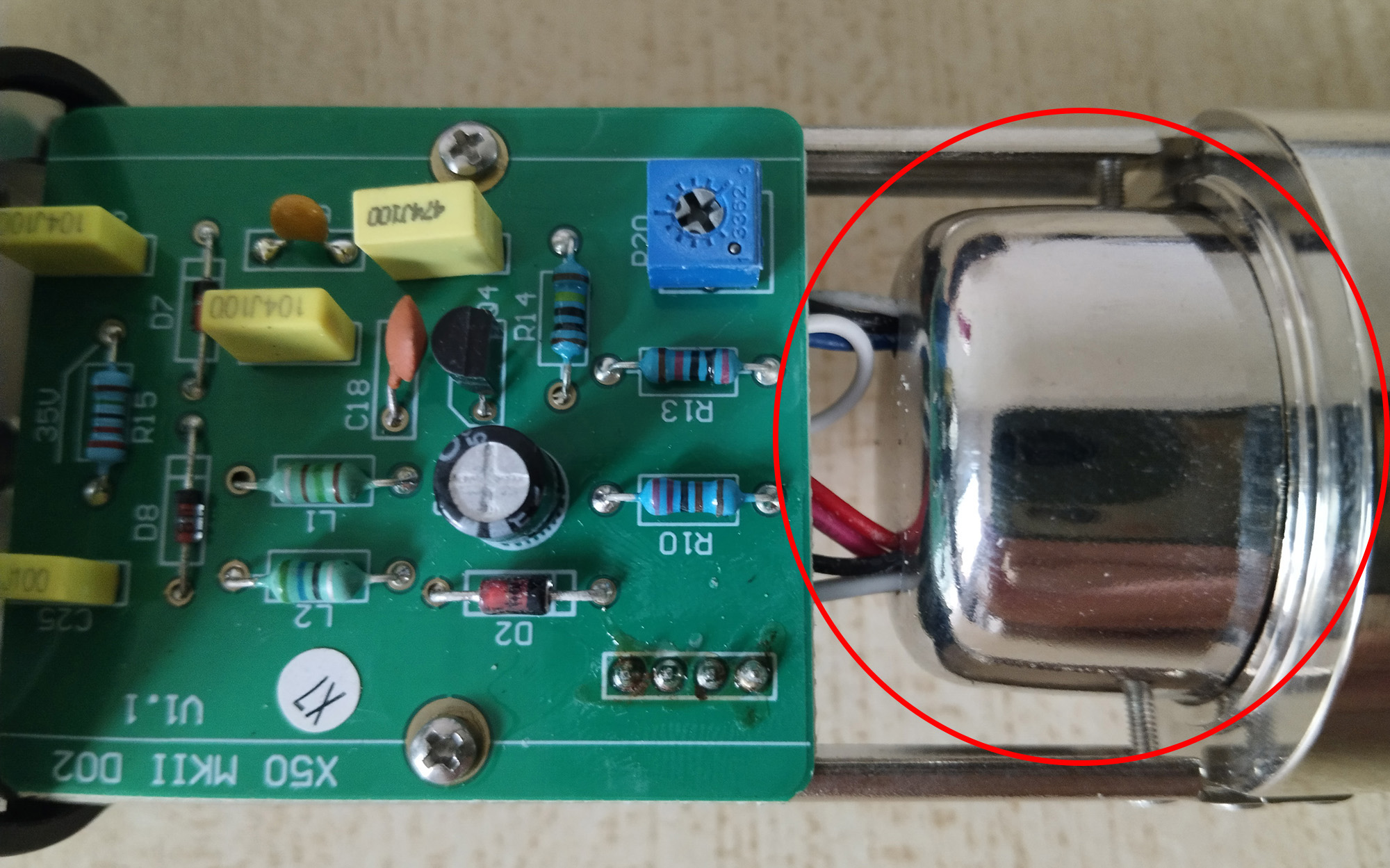
FET microphones, leveraging their advantages of low noise, high reliability, and cost-effectiveness, have become the industry standard in professional recording markets. While vacuum tube microphones remain irreplaceable for specific applications (e.g., vintage vocal textures), FET technology—through circuit optimizations such as transformer outputs and discrete component designs—has closed the gap in sonic expressiveness. Two key indicators define FET microphone quality: First, Signal-to-Noise Ratio (SNR), where professional models exceed 70dB (compared to entry-level units at ~60dB; the X50B MKII delivers 72dB). Second, frequency response flatness—the X50B MKII maintains ±2dB deviation across most frequencies, demonstrating exceptional linearity.
User Experience & Functionality
The X50B MKII’s “JFET + gold-plated diaphragm” configuration prioritizes high resolution and distinctive sonic character. Our evaluation protocol centers on validating these claims. Testing utilized the PreSonus Quantum ES4 audio interface with Ableton Live as the digital audio workstation (DAW), as shown in the setup diagram below.
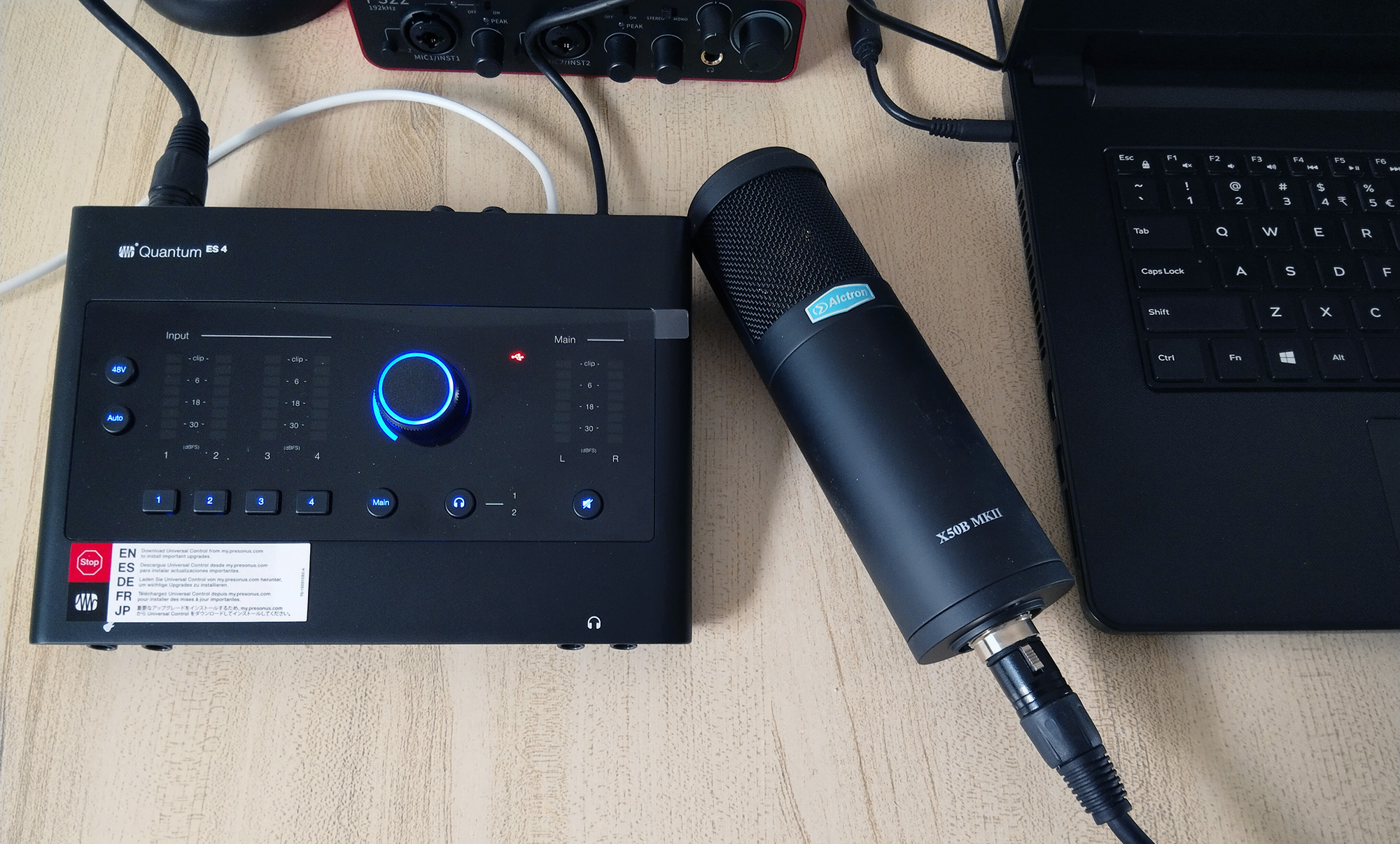
First, we evaluate the pickup capsule’s analytical power—its ability to capture intricate sonic details—with the 34mm gold-plated diaphragm serving as its core component. This test simulates real-world usage by recording high-frequency or rapidly transient sounds characterized by rich detail and dynamic waveform shifts, using their frequency response profiles as analytical benchmarks. The following graph displays four recorded waveforms: key collision, paper rustling, crumpling plastic packaging, and coin drop. (Listen to Recording 1)
JFETs (Junction Field-Effect Transistors) possess distinctive tonal characteristics including warmth, high-frequency refinement, and midrange richness. The following test employs a Superlux ECM999 measurement microphone alongside the X50B MKII to capture identical sound sources simultaneously. By comparing their respective waveforms, we objectively demonstrate the tonal variance between the two microphones. The test configuration featuring both microphones is illustrated in the diagram below.
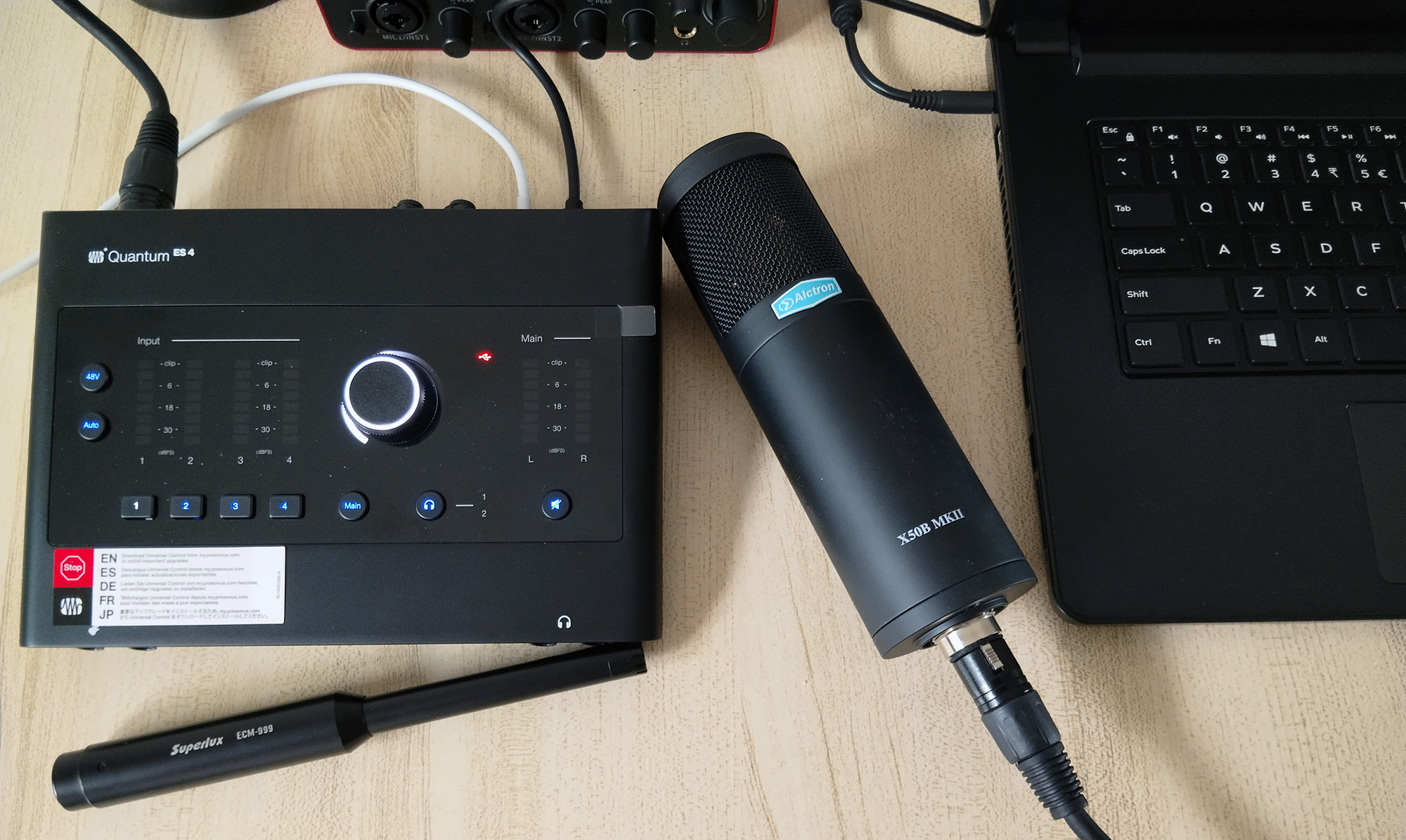
Speech Vocal Test – Designed to evaluate midrange/low-frequency performance. Two identical vocal passages were recorded at matched levels: the left figure displays the result captured by the Superlux ECM999 measurement microphone, while the right figure shows the recording from the X50B MKII. The corresponding waveforms are presented below.
FET circuitry often imparts a tube-like “analog warmth” to midrange/low frequencies. As evidenced in the spectral analysis below (green waveform: Superlux ECM999; purple waveform: X50B MKII), the X50B MKII exhibits significantly fuller and thicker midrange/low-frequency response, with richer high-frequency harmonic content. Its sonic character delivers natural smoothness, positioning itself tonally between the clinical directness of electret capsules and the lush density of vacuum tube microphones. (Note: The spectrogram’s real-time nature prevents visualization of complete dynamic variations.)
Full-Bandwidth Coloration Test – Demonstrates frequency response across the entire audible spectrum. The following figure presents waveform and spectral analysis of a synthesized piano timbre. Notably, high-frequency overtones retain greater harmonic detail, while low frequencies exhibit tightness and elasticity with a cleaner textural quality compared to vacuum tube counterparts. (Listen to Recording 2)
Noise Suppression Test – Designed to demonstrate the practical off-axis attenuation performance of the cardioid polar pattern. The figure below displays waveforms recorded at identical levels from four orientations: directly on-axis (0°), side angles (90°/270°), and directly off-axis (180°).
Measurement Data:
At 0° front: Level = -2.63 dB;
At 90° side: Level = -9.64 dB, actual attenuation = 7.01 dB (better than nominal -6 dB);
At 180° rear: Level = -20.6 dB, actual attenuation = -17.97 dB.
(Note: All levels represent peak values. Test results may vary due to environmental factors and are approximate; provided for reference only.)
Market Competitiveness, Pricing & Cost Performance
Core Selling Point 1: Handcrafted Capsule Design
As the core component for detail reproduction, its 34mm gold-plated large diaphragm forms the foundation for superior sound quality. The gold plating enhances diaphragm rigidity, while the expansive 34mm surface area effectively extends high-frequency response—capturing nuanced details like vocal sibilance or string harmonics—and improves high-frequency delicacy. The large diaphragm’s heightened sensitivity to low-frequency sound pressure boosts richness in elements such as vocal chest resonance or acoustic instrument overtones, ensuring robust low-end depth and auditory “solidity.” Additionally, meticulous manual tuning and component selection (e.g., capsule matching) minimize unit-to-unit variability, enhancing batch consistency.
Core Selling Point 2: “JFET + Transformer-Coupled Architecture”
First, the JFET input stage dictates transient response and dynamics. Its exceptionally high input impedance flawlessly matches the high output impedance of capacitor-based capsules, preserving even subtle transient details (e.g., drum hits, guitar picks, dental fricatives) without signal loss. The JFET’s streamlined circuit design reduces potential failure points.
Regarding the transformer: Its saturation characteristics generate even-order harmonic distortion, perceived by human ears as pleasant, full-bodied, and warm—adding sonic “color,” “analog character,” or “vintage warmth” akin to tube equipment or classic consoles. Furthermore, transformer design parameters (core material, winding technique, turn ratio) profoundly shape the microphone’s overall timbre, contributing texture, mid-low heft, high-frequency smoothness, or airiness.
Core Selling Point 3: Superior Price-Performance Ratio
Brands like Neumann, Audio-Technica, and Mojave Audio offer FET-type microphones. For example, the Audio-Technica AT5047, Mojave MA-201fet, and MA-301fet belong to the same category of large-diaphragm condenser mics. In terms of pricing and performance, the X50B MKII delivers exceptional accessibility.
Product Accessories: The X50B MKII includes a shock mount and pop filter. Peripheral accessories like storage pouches and flight cases are fully equipped, enabling immediate use out-of-the-box—ideal for beginners.
Performance Standards: Key specifications—frequency response, sensitivity, maximum SPL—meet professional microphone benchmarks.
Pricing & Target Audience: The Alctron X50B MKII retails for ¥1,480. Offering an affordable entry point to tube-like warmth and richness, it appeals to budget-conscious users seeking this signature style. Simultaneously, it serves as an ideal choice for those pursuing an “all-in-one” microphone or optimal fidelity across acoustic instruments, vocal recording, podcasting, and more.
Conclusion
The Alctron X50B MKII is an entry-level large-diaphragm tube condenser microphone designed for budget-conscious musicians, podcasters, and home studio users who seek the "warm tube sound." Featuring a professional-grade 34mm gold-plated diaphragm—a hallmark of premium condenser mics—it delivers an extended frequency response, superior transient capture, and excellent cardioid polar pattern. This design focuses on capturing sound directly in front of the capsule while effectively rejecting off-axis noise from the sides and rear, making it ideal for solo vocals, instrumental solos, or isolated sound sources.
Advantages:
▫️ The 34mm gold-plated diaphragm offers a wide frequency range, accurately reproducing rich low-end detail and delicate high-frequency overtones, particularly suited for warm-toned applications like vocals and acoustic guitar;
▫️ Ultra-low self-noise floor (17dB) combined with high sensitivity (-37dB ±2dB) enables pristine signal recording in quiet environments;
▫️ Professional polar pattern and noise suppression effectively isolate the primary sound source, significantly reducing ambient noise from the sides/rear—perfect for studio recording, live streaming, and scenarios requiring audio isolation;
▫️ Standard-included shock mount minimizes structure-borne mechanical vibrations, enhancing recording clarity;
▫️ Durable aluminum housing provides EMI shielding and physical protection, ensuring longevity;
▫️ Key components undergo manual quality inspection, guaranteeing circuit stability and manufacturing consistency.
Disadvantages:
▫️ High-impedance output (≤200Ω) demands higher-quality downstream equipment circuitry; entry-level audio interfaces may bottleneck its performance potential;
▫️ Lacks PAD (attenuation pad) functionality for controlling strong signals.
Purchase Recommendations & Perspectives
The X50B MKII excels at delivering warm, full-bodied, subtly vintage-characterized vocals (e.g., jazz, blues, rich pop male/female voices) and acoustic instruments with dynamic range. If these traits align with your needs, it presents exceptional value. Second, verify your downstream gear (audio interface/preamp) compatibility beforehand: Ensure 48V Phantom Power support and sufficient headroom to unlock the mic’s capabilities—budget interfaces may compromise its strengths. Third, poor recording environments (high ambient noise, untreated acoustics) will limit performance; prioritize room treatment where possible. Fourth, always use a high-quality shock mount and pop filter with large-diaphragm mics—start with the included accessories and exercise caution with third-party alternatives. Fifth, Alctron’s established reputation ensures reliable quality and customer support, justifying its brand premium.